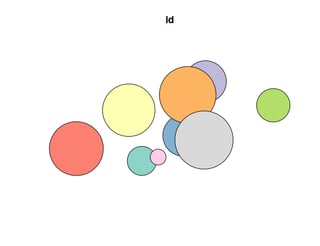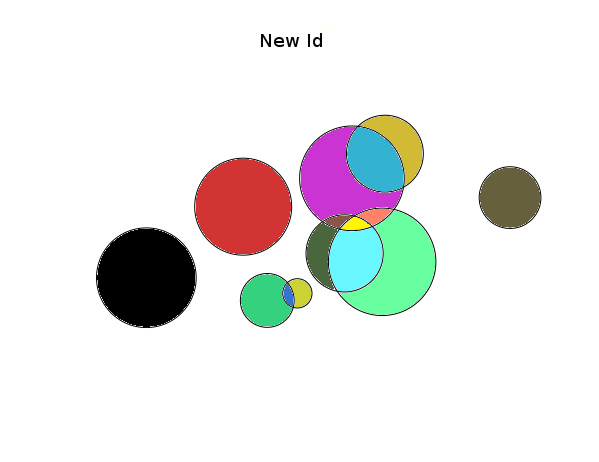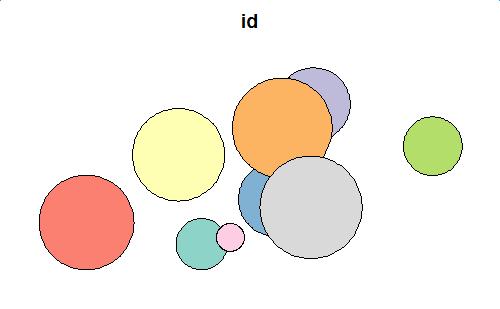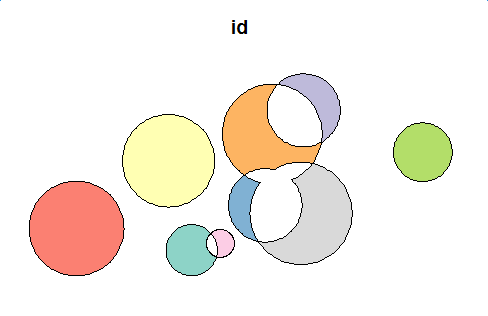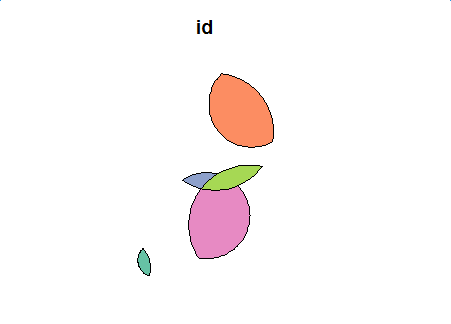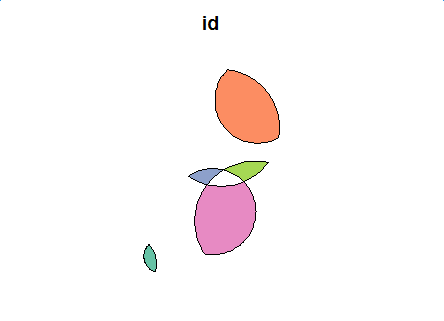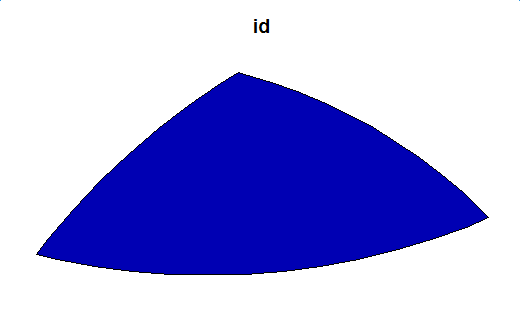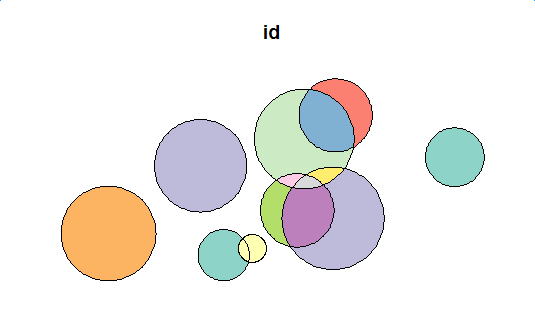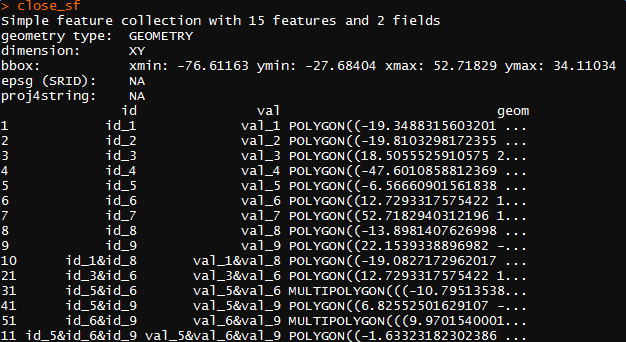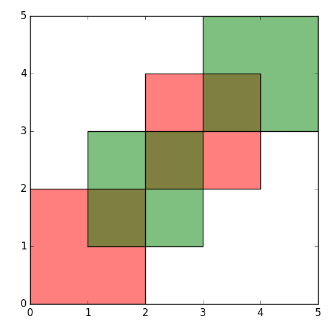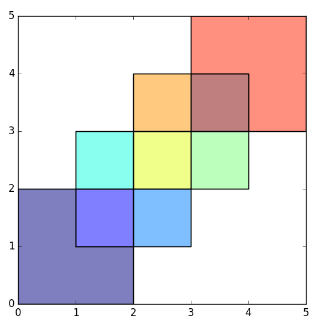Input
I modify the mock-up data a bit in order to illustrate the ability to deal with multiple attributes.
library(tibble)
library(dplyr)
library(sf)
ncircles <- 9
rmax <- 120
x_limits <- c(-70,70)
y_limits <- c(-30,30)
set.seed(100)
xy <- data.frame(
id = paste0("id_", 1:ncircles),
val = paste0("val_", 1:ncircles),
x = runif(ncircles, min(x_limits), max(x_limits)),
y = runif(ncircles, min(y_limits), max(y_limits)),
stringsAsFactors = FALSE) %>%
as_tibble()
polys <- st_as_sf(xy, coords = c(3,4)) %>%
st_buffer(runif(ncircles, min = 1, max = 20))
plot(polys[1])
![mock-up data]()
Basic Operation
Then define the following two functions.
cur: the current index of the base polygonx: the index of polygons, which intersects with curinput_polys: the simple feature of the polygonskeep_columns: the vector of names of attributes needed to keep after the geometric calculation
get_difference_region() get the difference between the base polygon and other intersected polygons; get_intersection_region() get the intersections among the intersected polygons.
library(stringr)
get_difference_region <- function(cur, x, input_polys, keep_columns=c("id")){
x <- x[!x==cur] # remove self
len <- length(x)
input_poly_sfc <- st_geometry(input_polys)
input_poly_attr <- as.data.frame(as.data.frame(input_polys)[, keep_columns])
# base poly
res_poly <- input_poly_sfc[[cur]]
res_attr <- input_poly_attr[cur, ]
# substract the intersection parts from base poly
if(len > 0){
for(i in 1:len){
res_poly <- st_difference(res_poly, input_poly_sfc[[x[i]]])
}
}
return(cbind(res_attr, data.frame(geom=st_as_text(res_poly))))
}
get_intersection_region <- function(cur, x, input_polys, keep_columns=c("id"), sep="&"){
x <- x[!x<=cur] # remove self and remove duplicated obj
len <- length(x)
input_poly_sfc <- st_geometry(input_polys)
input_poly_attr <- as.data.frame(as.data.frame(input_polys)[, keep_columns])
res_df <- data.frame()
if(len > 0){
for(i in 1:len){
res_poly <- st_intersection(input_poly_sfc[[cur]], input_poly_sfc[[x[i]]])
res_attr <- list()
for(j in 1:length(keep_columns)){
pred_attr <- str_split(input_poly_attr[cur, j], sep, simplify = TRUE)
next_attr <- str_split(input_poly_attr[x[i], j], sep, simplify = TRUE)
res_attr[[j]] <- paste(sort(unique(c(pred_attr, next_attr))), collapse=sep)
}
res_attr <- as.data.frame(res_attr)
colnames(res_attr) <- keep_columns
res_df <- rbind(res_df, cbind(res_attr, data.frame(geom=st_as_text(res_poly))))
}
}
return(res_df)
}
First Level
Difference
Let's see the difference function effect on the mock-up data.
flag <- st_intersects(polys, polys)
first_diff <- data.frame()
for(i in 1:length(flag)) {
cur_df <- get_difference_region(i, flag[[i]], polys, keep_column = c("id", "val"))
first_diff <- rbind(first_diff, cur_df)
}
first_diff_sf <- st_as_sf(first_diff, wkt="geom")
first_diff_sf
plot(first_diff_sf[1])
![first level difference]()
Intersection
first_inter <- data.frame()
for(i in 1:length(flag)) {
cur_df <- get_intersection_region(i, flag[[i]], polys, keep_column=c("id", "val"))
first_inter <- rbind(first_inter, cur_df)
}
first_inter <- first_inter[row.names(first_inter %>% select(-geom) %>% distinct()),]
first_inter_sf <- st_as_sf(first_inter, wkt="geom")
first_inter_sf
plot(first_inter_sf[1])
![First Level Intersection]()
Second Level
use the intersection of first level as input, and repeat the same process.
Difference
flag <- st_intersects(first_inter_sf, first_inter_sf)
# Second level difference region
second_diff <- data.frame()
for(i in 1:length(flag)) {
cur_df <- get_difference_region(i, flag[[i]], first_inter_sf, keep_column = c("id", "val"))
second_diff <- rbind(second_diff, cur_df)
}
second_diff_sf <- st_as_sf(second_diff, wkt="geom")
second_diff_sf
plot(second_diff_sf[1])
![enter image description here]()
Intersection
second_inter <- data.frame()
for(i in 1:length(flag)) {
cur_df <- get_intersection_region(i, flag[[i]], first_inter_sf, keep_column=c("id", "val"))
second_inter <- rbind(second_inter, cur_df)
}
second_inter <- second_inter[row.names(second_inter %>% select(-geom) %>% distinct()),] # remove duplicated shape
second_inter_sf <- st_as_sf(second_inter, wkt="geom")
second_inter_sf
plot(second_inter_sf[1])
![Second Difference Intersection]()
Get the distinct intersections of the second level, and use them as the input of the third level. We could get that the intersection results of the third level is NULL, then the process should end.
Summary
We put all the difference results into close list, and put all the intersection results into open list. Then we have:
- When open list is empty, we stop the process
- The results is close list
Therefore, we get the final code here (the basic two functions should be declared):
# init
close_df <- data.frame()
open_sf <- polys
# main loop
while(!is.null(open_sf)) {
flag <- st_intersects(open_sf, open_sf)
for(i in 1:length(flag)) {
cur_df <- get_difference_region(i, flag[[i]], open_sf, keep_column = c("id", "val"))
close_df <- rbind(close_df, cur_df)
}
cur_open <- data.frame()
for(i in 1:length(flag)) {
cur_df <- get_intersection_region(i, flag[[i]], open_sf, keep_column = c("id", "val"))
cur_open <- rbind(cur_open, cur_df)
}
if(nrow(cur_open) != 0) {
cur_open <- cur_open[row.names(cur_open %>% select(-geom) %>% distinct()),]
open_sf <- st_as_sf(cur_open, wkt="geom")
}
else{
open_sf <- NULL
}
}
close_sf <- st_as_sf(close_df, wkt="geom")
close_sf
plot(close_sf[1])
![final result]()
![enter image description here]()

